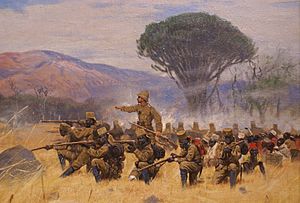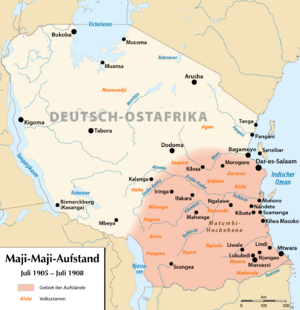Maji Maji Rebellion facts for kids
Quick facts for kids Maji Maji Rebellion |
|||||||
|---|---|---|---|---|---|---|---|
| Part of Scramble for Africa | |||||||
 "Battle of Mahenge", painting by Friedrich Wilhelm Kuhnert, 1908. |
|||||||
|
|||||||
| Belligerents | |||||||
|
Matumbi Ngindo, Ngoni, Yao tribes other Tanganyikans |
||||||
| Commanders and leaders | |||||||
|
Kinjekitile Ngwale † Nasr Khalfan Hemedi Muhammad |
|||||||
| Strength | |||||||
| c. 2,000 | ~90,000 | ||||||
| Casualties and losses | |||||||
| 15 Germans and 389 Askari | Unknown | ||||||
| 75,000–300,000 total dead by famine, disease, and violence | |||||||
The Maji Maji Rebellion (German: Maji-Maji-Aufstand, Swahili: Vita vya Maji Maji) was a big fight in German East Africa (which is now Tanzania). It happened from 1905 to 1907. Africans who followed Islamic and animist beliefs fought against the German rulers.
The Germans had taken control of this land during the Scramble for Africa in the 1880s. They wanted to make the local people grow cotton for export. This rule made many people very unhappy. Sadly, between 75,000 and 300,000 people died during this war, mostly from hunger.
Contents
Why the Rebellion Started
After European countries divided up Africa in the 1880s, Germany took over several colonies. These included German East Africa, German Southwest Africa (now Namibia), Cameroon, and Togoland.
The Germans did not have a strong hold on German East Africa. They used forts to control the area. Because their control was weak, they used harsh methods to rule the people. This led to local leaders like Susiye Baoka fighting back.
German Rules and Taxes
In 1898, Germany started making people pay taxes. They also forced people to work for free to build roads and do other jobs. In 1902, the German governor, Gustav Adolf von Götzen, ordered villages to grow cotton. This cotton was meant to be sold to other countries.
Each village had to produce a certain amount of cotton. Village leaders were made to oversee this work. This often caused problems between the leaders and the villagers.
Life Under German Rule
These German rules caused many problems for the local people. Their way of life changed quickly. Men were often forced to leave their homes to work. This meant women had to take on jobs usually done by men.
Also, with men away, villages struggled to feed themselves. In 1905, a drought made things even worse. All these problems, along with the forced farming and labor, led to the rebellion in July.
The Role of Magic and Belief
The people fighting the Germans turned to magic for strength. They used it to unite everyone against the colonizers. A spiritual leader named Kinjikitile Ngwale said he was possessed by a snake spirit. He called himself Bokero.
Bokero told his followers that they were chosen to remove the Germans. German visitors wrote that Bokero gave his followers a special "war medicine." He claimed this medicine would turn German bullets into water. This "medicine" was actually water (maji in Kiswahili) mixed with castor oil and millet seeds.
With this belief, Bokero's followers started what became known as the Maji Maji Rebellion.
The Uprising Begins
Bokero's followers were not well-armed. They mostly had spears and arrows, some with poison. But they were many and believed they could not be hurt. They marched from their villages with millet stalks on their foreheads.
At first, they attacked small German outposts. They also destroyed cotton plants. On July 31, 1905, Matumbi tribesmen attacked Samanga. They destroyed the cotton crop and a trading post.
Kinjikitile was arrested and executed for treason. Before he died, he said he had spread the rebellion's medicine everywhere. On August 14, 1905, Ngindo tribesmen attacked a group of missionaries. All five, including a Catholic Bishop, were killed.
Battles and Resistance
Soon, the Yao tribes joined the fight. Throughout August, rebels moved from the Matumbi Hills. They attacked German army bases across the colony.
On August 16, they attacked Ifakara. They destroyed the small German base there. This opened the way to a key fort at Mahenge. The German army in the south was small, with only about 458 European and 588 African soldiers. But they had strong forts and modern weapons.
At Mahenge, thousands of Maji Maji warriors attacked the German camp. They were led by another spirit medium. The German camp was defended by Lieutenant Theodor von Hassel with 60 African soldiers and two machine guns. The attacking tribes did not work together well. The first attack was met with heavy gunfire. The warriors fought for about 15 minutes, then retreated.
A second group of 1,200 men then attacked. Some got very close to the German lines before they were killed.
The Qadiriyya Brotherhood, a Muslim group, declared a holy war against the Germans. Sufi Muslims became a big part of the rebellion.
Ngoni Join the Fight
The Ngoni people also decided to join the revolt with 5,000 fighters. The Ngoni were Muslim and had arrived in the region more recently.
German troops, with machine guns, attacked the Ngoni camp on October 21. The Ngoni soldiers retreated. They threw away their bottles of war medicine, shouting, "The maji is a lie!"
Governor Gustav Adolf von Götzen asked for more soldiers from Germany. Kaiser Wilhelm quickly sent two warships. More soldiers also came from places like New Guinea. By October, 1,000 regular soldiers from Germany had arrived. Götzen felt ready to fight back and bring order to the south.
End of the Rebellion
The German forces used very harsh methods to stop the revolt. Three groups of soldiers moved into the rebellious southern areas. They destroyed villages, crops, and all food sources used by the rebels. They used their powerful weapons to break up rebel attacks.
A German group was ambushed while crossing the Rufiji River. This kept the rebellion going in the southwest for a while. But the Germans soon regained control. By April 1906, the southwest was peaceful again.
However, fighting continued in other areas. A German group under Lt. Gustav von Blumenthal faced constant attacks in May 1906. The fighting in the southeast turned into a guerrilla war. This led to a terrible period of hunger.
The Great Hunger
The German forces purposely caused this widespread hunger, known as the Great Hunger (ukame). Governor Von Götzen wanted to pardon common soldiers who gave up their weapons and leaders. But he also wanted to force the remaining rebels to surrender. So, he chose to use hunger as a weapon.
In 1905, a German captain wrote to Von Götzen, "Only hunger and need can bring a final surrender. Military actions alone will be like a drop in the ocean."
The last parts of the rebellion were finally put out in August 1907. The rebellion caused the deaths of 15 Germans and 389 African soldiers fighting for Germany. But it also led to the deaths of tens or even hundreds of thousands of rebels and local people. Many died from violence, disease, and especially from the famine.
See also
 In Spanish: Rebelión Maji Maji para niños
In Spanish: Rebelión Maji Maji para niños


